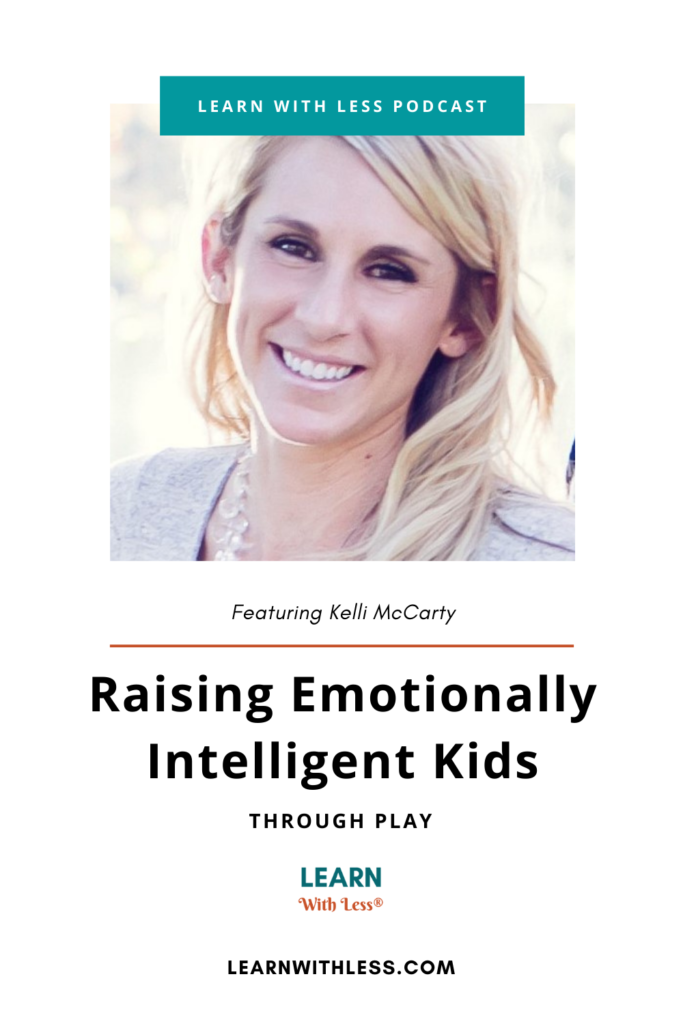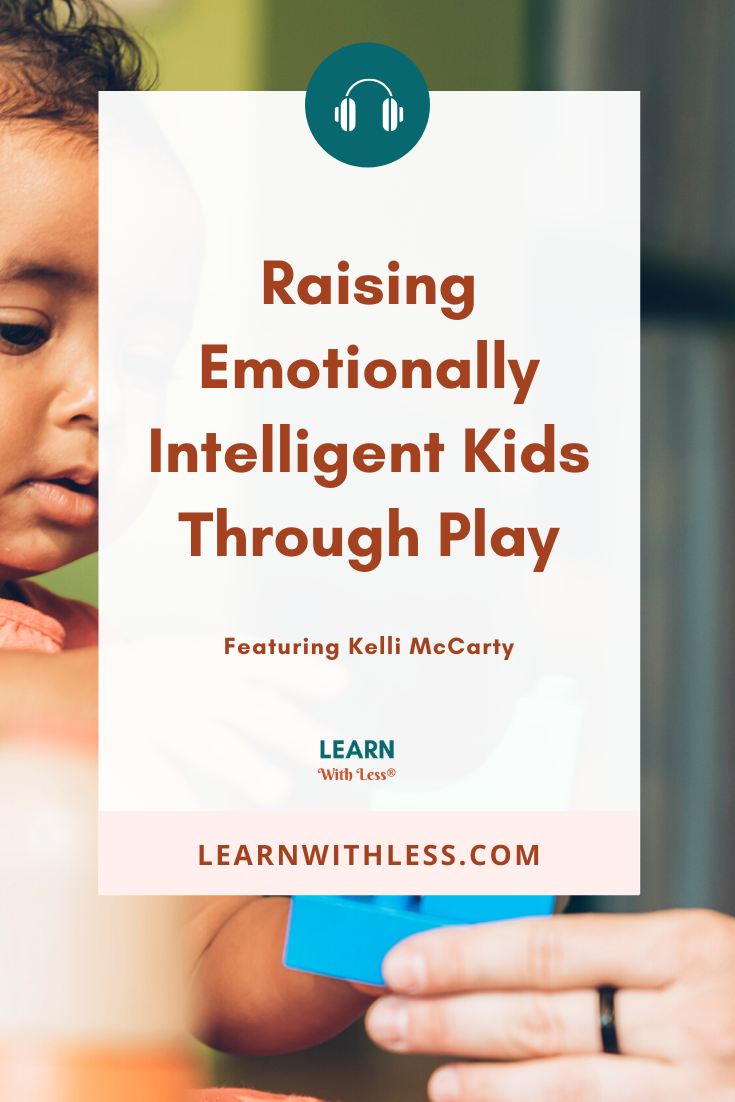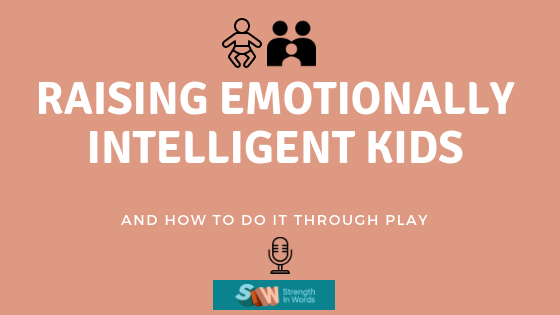How do we raise emotionally intelligent children?

On this episode of the Learn With Less podcast, Ayelet sits down with Kelli McCarty, a marriage and family therapist and founder of Toys With Intent, to discuss the ways in which we can raise emotionally intelligent children, how play factors into emotional intelligence in our young children, and Kelli’s top tips and resources for integrating social/emotional development and social cognition into play.
The basic takeaway? It really comes down to intentionality in the tools we choose to use in our parenting and in our homes.
Quick access to links in this episode:
1-2-3 A Calmer Me: Helping Children Cope When Emotions Get Out Of Control, by Colleen Patterson (affiliate link)
The Whole-Brain Child, by Dan Siegel (affiliate link)
Slumberkins (affiliate link)
Generation Mindful and the Time-In Tool Kit Generation Mindful’s mindfulness card games (affiliate link)
The Moodsters storybooks (affiliate link)
EQTainment board game (affiliate link)
CONNECT WITH US!
Ayelet: Facebook / Instagram / Pinterest / YouTube
Kelli: Website / Facebook / Instagram
Text transcript of this episode
Ayelet: Welcome to episode 65 of the Learn With Less podcast. Today I’m speaking with Kelli McCarty, a marriage and family therapist who has worked in schools and in the mental health field for over 10 years. Kelli now runs Toys With Intent, a website dedicated to providing social and emotional resources for families with young children and with teens.
Her mission is to help parents raise children to be more emotionally intelligent and to help parents become more intentional about the toys and products they bring into their homes. Kelli, thank you so much for being here and welcome to Learn With Less.
Kelli: Thank you so much, I’m so happy to be here.
Ayelet: So I have asked you to come onto the show today to speak about raising emotionally intelligent children. But first I’d just love to hear a bit more about you and how you got into the work that you’re doing today.
Kelli: Sure! As you heard in the introduction, I am a marriage and family therapist and former school counselor, and a mother, too. And I really started Toys With Intent kind of wrapping all those experiences together, but mostly because I was kind of, for lack of a better word, appalled at some of the toys and products and books out there for children.
There seemed to be a lack of educational and healthy toys and products out there that really enhance children’s development or they were really hard to find, and I would often get these kind of pointless toys or books that were given to my children that didn’t really have a positive message, either. So I basically wanted to do something about that.
So I created the website Toys With Intent, so parents and educators could find helpful educational, social-emotional books and toys all in one place. And then, ideally the parents and educators would use these toys to help enhance their child’s EQ. So really, Toys With Intent, is a place where you can go to find better and more helpful toys, books and products for kids.
Ayelet: Wonderful and necessary. That’s great. Because as we all know, there’s so much stuff out there and it can be really hard. I mean, you and I are both in existence because we both wanted to create something that was sort of a hub for people to be able to come and create that high quality resource for families. I love what you’re doing. Great.
So I would love for you, this is sort of a big question, but can you break it down for us? How does play factor into what you’re calling emotional intelligence in infants and toddlers and I guess with that, what is emotional intelligence?
Kelli: So emotional intelligence is really the ability to understand yourself and to understand others. I mean that’s what it is at its core. And so when we think about how to develop that in children, we look to play because play is really the work. It’s the work of a child. That’s what they’re doing. That’s all they really know and that’s how they experience the world.
And for me, I’ve always said, okay, so if play is the work, then the toys are the tools, right? So the toys or the tools that children play with can really be influential in helping to develop the child’s EQ, I know you know this, but one of the first EQ skills babies learn is recognizing facial expressions and cues, right, in themselves and others and this ability to recognize their own emotions and the emotions of others is a necessary skill to be able to interact with others, show empathy, demonstrate appropriate social skills later in childhood and throughout life.
So when we think about how babies and toddlers play, and what they play with, parents and caregivers can certainly start to develop these EQ skills by utilizing things like mirrors, right? For example, where the baby can see different expressions. When babies or toddlers are playing with dolls with different facial expressions. A parent can say, you know, why is that dolly upset? Or why is that doll sad? You know, a big part of play in childhood is also books, the books that children read. So, even when you’re reading a story and little Johnny gets upset and the story the parent can work it through with the child, very young child can start to understand, look, he’s crying, that means he’s sad – naming out loud the emotions of others.
So, again, when you look at what the child is actually playing with, it can be really helpful in teaching these emotional intelligence skills. Like I mentioned, there’s a lot of kind of pointless toys or maybe almost harmful products out there that actually are kind of counterintuitive to teaching the skills that we want, especially when you get into the preschool years.
There’s stories about children whining and misbehaving and getting what they want and acting out, and as a parent, those probably aren’t the skills we want to be enhancing and encouraging in your child. So really, with the play, and the toys and the books you choose, you can be reinforcing the values and skills you want to be teaching through the actual toy.
Ayelet: Ah, that’s really nice. I love how you put that. You’ve used the term EQ a couple of times. Would you please define that for our audience in case people are not sure what that means?
Kelli: Sure, so EQ is just a shortened phrase for emotional intelligence, which again, is just understanding yourself, having an awareness of your own emotions and the emotions of others.
Ayelet: Wonderful. And this is, of course, this is social-emotional development, but it’s also part of an area of cognitive development as well and what we talk about as far as social cognition, which is that understanding… I can’t break it down enough, right? Because it’s all totally related and as we talk about a lot on the Learn With Less podcast, all of those areas of early development in the early years, especially the infant and toddler years are so intertwined, right?
This is social-emotional development, this is social communication, this is social cognition. It’s all interrelated, and it all feeds into each other. So, let’s just take a quick break to hear a word from our sponsors, and then we’ll hear a few tips and resources from Kelly about integrating social-emotional development and social cognition into play as well as a few of her favorite resources that she likes to recommend to families who are interested in seeking out things about this topic.
Ayelet: Okay, Kelli, let’s hear a few of your top tips for families who are looking for more ideas to integrate these aspects of social and emotional development, social cognition, emotional intelligence, into play.
Kelli: Yeah, I think the first thing is just to be really mindful of the toys and books and products that you choose. You know, you mentioned that there can be so much and actually research says more toys does not equal better. In fact it’s overwhelming for the child. And there’s actually a lot of negatives to having too many things.
So first, that’s definitely the message I want to send home is that you don’t need all these books and toys and products. But when you do bring home some, make sure they’re intentional. You know, again, every toy and book has a message. So it’s important to really evaluate what that message is sending and what it’s teaching your child. You know, I mentioned books earlier. To me, that’s kind of the easiest because I think almost every parent reads their child a book before bed – babies through preschool children, and so on. So I really view books as a really easy way to incorporate social/emotional development in children.
There’s a book called “One, Two, Three, A Calmer Me,” “Bye, Bye, Toddler Time.” I mean there’s so many different books that you can read every night… instead of princesses and dinosaurs, why not read a book about empathy and kindness and, you know, all the appropriate skills you want to be teaching. It’s a very kind of simple shift that you can do that can actually really change your child’s development.
You know, I talked about the mirrors, that’s kind of another way you can kind of incorporate them facial expressions. Talking out loud -whenever you see in a book or a show or whatever, different emotions. Although your child’s young, this is their development, right? It’s all sinking in.
You know, another thing is that the dolls and toys you have should really reflect the world that we live in. This is another way to enhance your EQ is to bring diversity to toys and books. You know, different races, body types, non able bodied people. This exposure early will definitely help them, you know, as they grow in the future, it won’t be something strange or new. Understanding others, again, is a huge part of EQ, and you can do that with your toys – just diversifying them.
I know screen time can be a very controversial topic, but if you do decide to do screen time, there’s also a simple shift you can make. Again, instead of Mickey Mouse, you can choose Daniel Tiger, which always incorporate social/emotional themes, a spin off of Mr. Rogers. So, for every toy or book there is, there’s actually a positive one, that you could do a simple shift out, if you want to do it that way.
Ayelet: I love it because it’s really so much about being intentional, and that’s really it. I mean it’s just, like you said, it’s a very simple shift into how we are exposing our children to the world. I believe as well in that power of… what did you say? You said teaching about others, right? That is such a wonderful way to expose a child to people who look different from them. People who do things differently, whether that’s your next door neighbor or a person across the world. That’s wonderful.
And of course that’s also how our children are categorizing things, right? They’re already categorizing what a girl does versus what a boy does or, I mean, you mentioned to me earlier that you have a three-year old. I have a four and a half year old. It’s true – it’s like it’s incredible what they come up with as far as, like from a year ago to now, what my child “believes” about the world based on other people that he’s been exposed to, other things that he’s categorized or classified.
Kelli: Well, stories, too, right? If they read in a book that the doctor is always a boy and, you know, it’s always a white mommy and a white daddy… I mean this is how a child frames their world, so the non-gender toys and letting boys play with dolls… I mean there’s all sorts of different ways to help break down some of the stereotypes that get formed at a very, very young age. Like you just mentioned, a four and a half year old can already kind of compartmentalize different categories.
Ayelet: Yeah. Thanks for breaking that down for us. Now, can you give us a few of your favorite resources to share with families who are looking for more places to find this good stuff?
Kelli: Sure, yeah. A big part of my job is searching all of this out, it’s finding the best stuff that’s out there because, like I said, for every toy out there, there’s a positive version of it. I do believe that. I know there’s a lot of infants and babies and toddlers in your community, so I’ll mention Slumberkins – are you familiar with them? So they were actually on Shark Tank, but what it is, it’s a little plush doll or toy, a stuffed animal, but each of them comes with a little story about… one of their topics is mindfulness, conflict resolution.
They have all these different “positive life skills” is what they call them and basically the plush toys serves as sort of a security attachment and then they have these positive stories that you read each child every night. So they really start young, they’re, you know, right out of the womb. They’re like, here’s a, here’s a positive story you can read your child every night and here’s the security plush toy to go along with it. So I like them because they start really, really young.
Generation Mindful – that’s another great resource. They came up with the “time in” versus the “time out.” So the creators of that have a whole toolkit and they have, you know, mindfulness card games. Again, once your children get a little bit older and they get into board games and stuff like that, there’s positive, you know, SEL (social emotional learning) board games too that exists and kids really don’t notice the difference if it’s fun and engaging. So, Generation Mindful is also an amazing resource. I have their Time In Tool Kit. I use that to help teach emotion regulation for my three year old, which again, being able to manage your emotions is huge for emotional intelligence.
I know this is more for parents, but anything by Dan Siegel we’re a huge fan of – The Whole Brain Child is a great resource just to kind of understand your child better. So I like, I like his books. We have a lot of parenting books on the website as well as your children get into the maybe the preschool and the early elementary school years.
There’s a line called the Moodsters, and they’re essentially just little characters, but each of them it’s representative of a different emotion. So there’s Quigley for scared and there’s Razzie who’s the angry, you know, monster. And I use that with my daughter and she just thinks that they’re just like Disney characters to her. She doesn’t know the difference. Right? Oh, that’s Razzie…
Ayelet: They very much actually remind me of the Pixar movie, Inside Out.
Kelli: That’s another great resource that they get a little bit older. I mentioned the board games. There’s a line called EQtainment, or EQ is the board game and it teaches social skills and that’s more for like five, six, seven, eight year olds. But again, just just being mindful that every toy you have, there’s a different version of it and a healthier way.
Ayelet: Earlier you mentioned just the simple idea of looking at pictures or books. And of course, again, you don’t even need a book for this. You can literally skim through a magazine and look at faces and talk about what they look like or how they’re feeling or who they are or what they’re wearing. And that’s so much vocabulary that you’re giving your child just in observations. And of course teaching them to be observant.
Kelli: Again, you don’t even need anything – you can be at the playground, right? It’s, that’s a very simple way of when you’re walking around or you see people, someone’s hurt or someone’s angry, like you said, just building a vocabulary. That’s a great point is that it’s another kind of basic skill that if they can’t name the emotion, that’s a number one starting point, so using those words out loud is really, really helpful in helping them to form that EQ as they get older.
Ayelet: Wonderful. Well thank you so much Kelly, and of course we can find you at toyswithintent.com and you’ve got a ton of great resources on your website as well and we’ll link to all of that in the show notes for people who’d like to find you again and see more of what you’ve got to offer.
And then, thank you so much to all of our participants of the Learn With Less™ Curriculum who are here listening live. We’re going to now open the discussion up for a Q&A session for you guys in just a minute and for everyone listening from home or on the go, thank you so much for joining us and we will see you next time!
Kelli: Bye, thank you!

